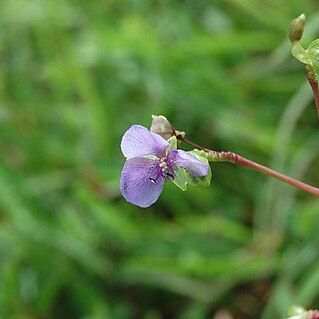Herbs perennial. Roots fibrous, robust, 2--3 mm in diam., densely lanate. Rhizomes absent. Main stem undeveloped, short, with basal, rosulate leaves; fertile stems 2--4 arising from base of main stems, usually erect, sometimes ascending, to 50 cm. Basal leaves with sheath hirsute only on 1 side; blade linear, 15--35 × 0.6--1.5 cm, glabrous. Cauline leaves often 2 or 3, rarely more; proximal leaf blades to 12 cm, distal ones shorter, sometimes only ca. 10 mm, glabrous. Cincinni several, to 2 cm, forming narrow panicles ca. 5 cm; peduncle ca. 10 mm; involucral bracts ovate or ovate-lanceolate, less than 10 mm, membranous, caducous; bracts subequaling sepals, caducous; flowers pendulous in bud, ascending at anthesis; pedicels straight, ca. 5 mm in fruit. Sepals elliptic, 4--5 mm. Petals purple, obovate-orbicular. Fertile stamens 2; filaments bearded; staminodes 3; antherodes 3-sect. Capsule ovoid-globose, trigonous, 4--5 mm. Seeds 2 per valve, brown-black, white radiate verrucose. Fl. Apr--Sep.
Gregarious, herbaceous, subscapose, perennial herb, up to 0.6 m high. Leaves mostly basal, linear, up to 200 mm long and ± 10 mm broad. Flowering shoot up to 500 mm tall. Peduncle with a few reduced leaves. Thyrse terminal or terminal and axillary. Flowers mauve.
An erect or sprawling herb. It grows 1.3 m tall. It can have a tuberous rootstock. The leaves are narrow and grooved. They are 20 cm long by 1 cm wide. They sheath the stem at the base. The flowers are blue and in racemes at the end of stalks.
Panicles of blue to mauve flowers opening in late afternoon evening, about 4-6.30 p.m.
A rather robust, erect or sprawling herb 6 in. to 4 ft. high
Long lower leaves


